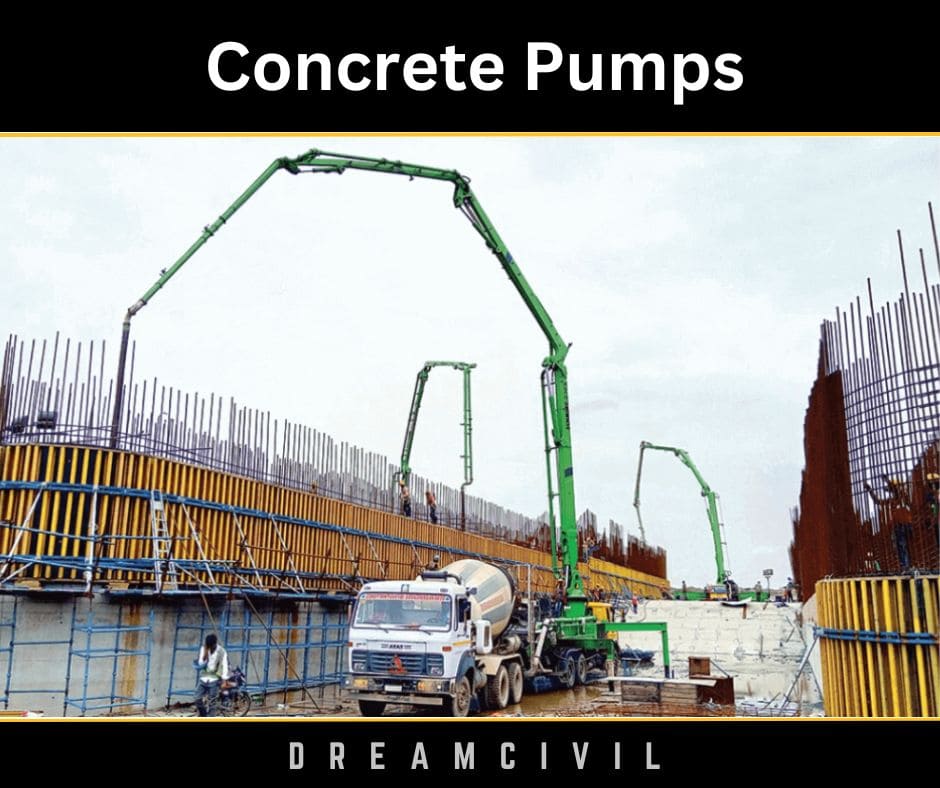Table of Contents
Concrete pumps are tools to move liquid concrete from the concrete source to the casting location.
1. Principle of Concrete Pump
A concrete pump was invented initially as a two-cylinder hydraulic pump. This functions by the principle of one piston drawing the concrete from the hopper (concrete source) and the other piston forcing it into the discharge outlet pipe.
Determining which cylinder has to be opened to the hopper and which must be opened to the discharge pipe is handled utilizing a valve.
With future developments, variations in this design were believed to facilitate high-pressure pumping when concrete has to pump at various heights and lengths. This growth got great demand in the fast construction of high-rise buildings.

2. Types of Concrete Pumps
Various concrete pumps have been invented and established on the pumping pressure, ease of working and developing technologies.
The main classification of concrete pumps are:
1. Line Concrete Pumps
2. Boom Concrete Pumps
1. Boom Concrete Pumps
Boom concrete pumps remain at one certain place for the whole duration of concrete flows on a construction project.
Hence these are stationary concrete pumps. They own a more significant dimension which is set on the ground. These own cranes or boom arms connected to them in various lengths.
Concrete pumping to various elevations, like in the construction of high-rise buildings, can be achieved by boom concrete pumps. Boom concrete pumps permit the pipeline to arrive along, upwards, and below.
Hence close locations can be cast by these pumps. Such pumps can efficiently overcome obstacles during the concrete casting path.

2. Line Concrete Pumps
Line concrete pumps are compact units primarily employed for small construction projects. The arrangement owns a line pump connected to the back of the truck or the trailer.
Hence the arrangement is also called a trailer-mounted concrete pump or truck-mounted concrete pump.

3. How to Choose a Concrete Pump?
The concrete pump is chosen depending on the needs of the construction project. A suitable and appropriate selection of concrete pump is determined depending on the following elements:
1. Manufacturer of the Concrete Pump
2. The purpose of the Concrete Pump
3. The complexity of Construction Projects in terms of casting
4. Price and economic factors
1. Manufacturer of Concrete Pump
Essential elements considered in choosing an ideal concrete pump manufacturer are:
1. Choose the most suitable manufacturer of concrete pumps in the area. Request the area contractors and seek help from known manufacturers for this.
2. Now, a vast combination of opportunities can be considered online. Check high-rated concrete pumps and their customer reviews.
The concrete pumping process is conducted under high pressure. A suitable concrete pump must be capable of resisting this long-term pressure.
If the quality of the concrete pump is below average, it outcomes in breakdown and loss for the construction projects.
2. Purpose of Concrete Pump
The concrete pump must fully meet the objective for which it was purchased.
For example, if a concrete pump purchased could not be utilized to fill the mid-portion of a tunnel under construction, the pump is said to have no use for the construction project.
Thus the contractor or constructor in command must inspect whether the concrete pump purchased is versatile and own unique functionalities.
3. Price and Economic Factors
The concrete pump must be reasonable and perform based on the bought rate. Avoid the chances of buying an underperformed concrete pump for a very high rate. Constantly choose a concrete pump depending on its performance and price. Compare the performance and the price.
4. Concrete Pump Selection Based on Work
When the concrete pump is chosen depending on work, two major elements are evaluated:
1. Volumetric Concrete Output
2. The Pumping Pressure
The maximum volumetric concrete output needed per hour for concrete construction is chosen. Depending on which pressure of the pump is fixed. This pressure is the specification employed to choose the concrete pump.
The desired concrete output (Q) and the pumping pressure (P) select the power of the driving unit of the concrete pump. Then the hydraulic output (H) is given by:
H = Q x P ——- Eq.(1)
The concrete pump noted above can be chosen depending on various construction works.
1. A boom or truck-mounted concrete pump is best suited for building massive road and highway projects.
2. A boom concrete pump is the most satisfactory option for concrete flowing at many altitudes, with a limited area for concrete flowing.
3. Boom concrete pumps can establish two or three robotic pump lines that act as multi-purpose robotic arms where the need for labor will be less.
4. A-line concrete or stationary pump is selected to build sidewalks or slabs. The stationary pump is chosen wherever a small quantity of concrete pumping is needed.
5. Prices of Concrete Pumps
The price of concrete pumps varies from 85 lakhs-2.5 crores Indian Rupee.
6. References1. Content Filter & Authenticity Checking Team, Dream Civil International (Our team checks every content & detail to maintain quality.) |
Read Also: Pipe Union Fitting

